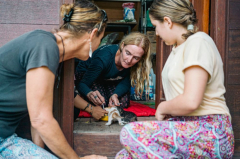Sumatra Wildlife Centre rescues animals from poaching and trade—hopeful stories of survival, compassion, and wild return.
Head wildlife career Herman parks the ute and we grab backpacks and start walking, following a mossy trail past coffee bean trees and banana palms into the jungle. Clambering over the buttressed roots of decades-old strangler figs, the haunting song of siamang gibbons echoing through the mist, we finally reach a small clearing deep in the forest known as Raja Besar, the “Great King”.
Here, using timber and aluminium beams carried along the same forest foot trail, a handful of workers are building a modest hut — two small sleeping rooms, a bathroom and spaces for cooking and eating. Everyone is pitching in with the communal work and, even with the hubbub of grinding and hammering, this jungle scene is spectacularly beautiful.
This is a clearing full of hope. Within days, a large animal enclosure will be added and Tjing’s Jungle School will welcome a tiny sun bear cub named Mano. Her mother murdered by poachers, Mano was sold to wildlife traffickers whose planned shipment to the United Arab Emirates was intercepted by Indonesian police and a rescue team from Jakarta Animal Aid Network (JAAN).
At four months old, weighing less than a domestic cat, Mano arrived at JAAN’s Sumatra Wildlife Centre (SWC) in need of the sort of intensive, around-the-clock care that a mother usually provides. The level of commitment it takes to save a baby sun bear is utterly astounding: one full-time carer providing through-the-night bottle feeding, a constant supply of fresh, ripe fruit, twice-daily walks, ever larger enclosures, veterinary checkups and now more than two years of jungle training by carers living with Mano in the forest.
Then, at the end of this very long road, the Sumatra Wildlife Centre team must secure government permits to release Mano into the wild, in a national park large enough to protect one of the world’s rarest, most endangered, tortured and trafficked “pets” from humans.
This is what JAAN does best
A not-for-profit, non-governmental wildlife network with privately funded rescue centres in Sumatra, Java and Bali, JAAN works with Indonesian police, government forestry officials and its own highly trained team of sniffer dogs to track, rescue, rehabilitate and release an astonishing range of wild animal species.
On Kotok Island off the Javanese coast, the organisation cares for and releases sea eagles and other raptors. In west Bali, its veterinary team nurses injured sea turtles saved from the meat trade, while still more JAAN professionals and volunteers work to rescue long-tailed macaques — the so-called “dancing monkeys” — from a tortured life on Indonesian streets, performing for cash at the hands of brutal captors.
All this work is done on donations. Founded in Indonesia in 2008, JAAN’s wildlife and marine programs are the life’s work of co-founder Femke den Haas, whose infectious enthusiasm, patience and ambition have gathered a bevy of animal activists to her side. Some call her a force of nature, and we are drawn to that energy, too. Two years after sailing into a west Bali anchorage beside her sea turtle and dolphin rehabilitation centre, we are lured back to photograph the work at Sumatra Wildlife Centre.
Wild encounters
Femke den Haas dangles the ultimate carrot. “You’ll be staying in the hut next to Mano,” and that’s how we meet our first ever sun bear, walking up the stairs to our temporary Sumatran home.
Built on gifted land on the outskirts of a small Indonesian village, on a known smuggling route for the world’s illegal wildlife trade, the Sumatra Wildlife Centre accepts every poached, injured and too-often tortured and rescued creature that reaches its gates.
Some have been rescued by JAAN’s own K9 team of specially trained wildlife sniffer dogs that intercept wildlife trades and deliver to the SWC an ever-changing assortment of native and exotic wildlife species: crocodiles, sun bears, raptors and meerkats, endangered agile gibbons, macaques, civets and leopard cats.
The aim is always to rehabilitate and release back into the wild, but for infants targeted by poachers, those rescued from torturous lives in captivity and for exotic species trafficked from other countries through Indonesia, the journey back can take years.
From small beginnings, the centre has grown to include a veterinary clinic, a kitchen for preparing the animals’ meals, kennels for the sniffer dog team and basic sleeping quarters for the centre’s resident staff. There are animal enclosures and compounds for every species: crocodile ponds and a meerkat playground, multi-storey enclosures for arboreal dwelling siamangs and lightning-fast agile gibbons, great netted pens for injured raptors and sheltered nocturnal enclosures for a lonely slow loris, a singular civet and a Sunda leopard cat.
Anything and everything find their way to the SWC, keeping carers and vets on their toes. Every day begins the same, preparing huge amounts of fresh food. Much of it is harvested from the centre’s adjacent pesticide-free plantations, and all of it must be carefully washed, chopped and weighed to create personalised food bowls for each animal.
There are salads of fruit and vegetables for the omnivorous primates, corn cobs and seeds for parrots, live mice and meat for the wild cats, and fish for the crocodiles. There’s even the occasional treat of drinking coconuts for playful sun bears to tap into. While the animals feed, every enclosure is thoroughly cleaned and fresh vegetation is added to provide cover, shade and for play.
The staff work at a cracking pace. In the space of our week-long stay, we watch new enclosures taking shape, including a huge compound for Mano and a soon-to-arrive sun bear cub named Henri that the staff hope to unite. Wildlife don’t always instantly make friends, but family groups and partnerships are essential for survival after release back into the wild.
Precious primates
Common in Indonesia, macaques have few rights and their endearing humanlike qualities, as infants at least, make them highly desirable, albeit extremely unsuitable pets. They are sociable creatures that live in large troupes in the wi





